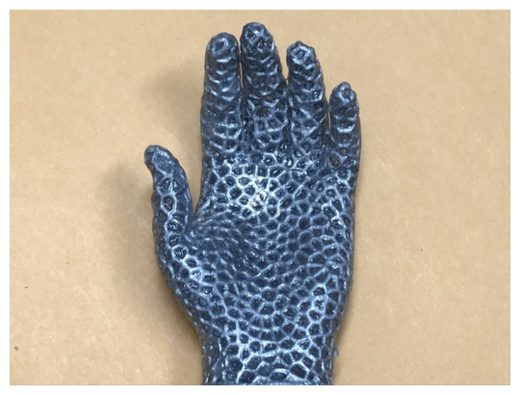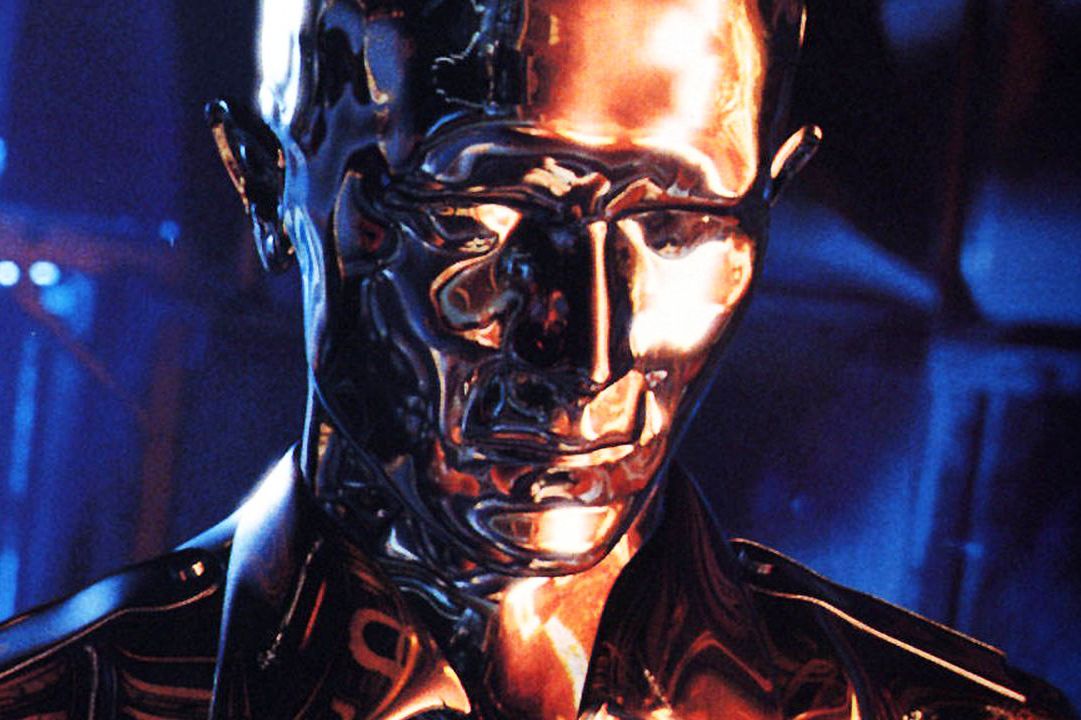A liquid metal lattice that can be crushed but returns to its original shape on heating has been developed by Pu Zhang and colleagues at Binghamton University in the US.
Physics World
Tue, 26 May 2020

Handy material: this model of a human hand was made using a liquid metal matrix.
The material is held together by a silicone shell and could find myriad uses including soft robotics, foldable antennas and aerospace engineering. Indeed, the research could even lead to the creation of a liquid metal robot evoking the T-1000 character in the film Terminator 2.
The team created the liquid metal lattice using a special mixture of bismuth, indium and tin known as Field’s alloy. This alloy has the relatively unusual property of melting at just 62 °C, which means it can be liquefied with just hot water. Field’s alloy already has several applications – including as a liquid-metal coolant for advanced nuclear reactors.
Zhang and colleagues combined the alloy with a silicone shell through a complex hybrid manufacturing process that combines 3D printing, vacuum casting and so-called “conformal coating” – a technique normally used to coat circuit boards in a thin polymer layer to protect them against the environment. The silicone shell is what allows the lattice to “remember” a desired shape and restore such when the alloy is melted.
Shell skeleton
“Without the shell, it won’t work, because the liquid metal will flow away,” Zhang said. “The shell skeleton controls the overall shape and integrity, so the liquid metal itself can be confined in the channels.”
To illustrate the potential of the lattice technology, Zhang and colleagues made several demonstration structures – including honeycombs, the letters BUME (for Binghamton University mechanical engineering), a spider web-like mesh and a lattice in the shape of a human hand. When crushed and reheated, all eerily return to their original shape.
When solid, Field’s alloy is very strong and stable and is far stiffer than most shape-memory polymers, according to Zhang. A crucial benefit of the new material is that an object can easily be crushed down into a much smaller spaces for transport or storage before being restored to its usual shape. The researchers think this would make the material ideal for use in space missions, where it could be used to make antennas or building superstructures that could packed tightly on spacecraft ship and then expanded on arrival on the Moon or another planet.
Space cushions
The material could also be used to make cushions because it can absorb a considerable amount of energy when crushed. Zhang suggests that this could be useful for building reusable spacecraft. “Normally, engineers use aluminium or steel to produce cushion structures,” he says. “After you land on the Moon, the metal absorbs the energy and deforms. It’s over – you can use it only once.”
In contrast, a spacecraft with landing cushions built using a liquid metal lattice could be reused over and over again. “Using this Field’s alloy, you can crash into it like other metals, but then heat it up later to recover its shape,” Zhang said.
“There’s been growing interest in machines and structures that can change their shape, stiffness, and ability to bear load. These architectures have potential use in emerging applications like soft robots that mimic biological organisms, wearable computing systems that can conform to the body’s natural motion, or wearable robotics that can assist in human motor tasks,” says Carmel Majidi, a mechanical engineer from the Carnegie Mellon University. “[This work] nicely builds on past research in stiffness tuning and shape memory materials,” he says, adding it. “is an excellent demonstration of how low melting point metals can be used for creating smart and adaptive structures”.
Enormous changes
Michael Dickey — a chemical engineer at North Carolina State University agrees, adding, “This work nicely takes advantage of the capabilities of 3D printing, the elastic energy of elastomers, and the enormous changes in modulus that occur when low melting point metal alloys melt”.
With their initial study complete, the researchers are now working to improve the durability, strength and energy absorption capacity of their liquid metal lattice materials – alongside scaling up and refining the manufacturing process for such.
Zhang also has another goal in mind. “Our dream is to build a liquid metal robot,” he said. “Now we have a hand, so we’re one step further.
The research is described in the journal Additive Manufacturing.

Martin comments: These developments usually enter military applications before filtering through to the civilian world. Imagine armies of indestructable self-healing robots? On the other hand it may spell the end of fender-benders in the car park.
Makes me think of Roswell and the alleged material from the crashed saucer that returned to it’s original shape when deformed. A visitor from the future rather than from another world…?


Get your copy from our Online Store or your local book and magazine retailer
Australian Retail Locations » Uncensored Publications Limited
New Zealand Retail Locations » Uncensored Publications Limited
As censorship heats up and free thought becomes an increasingly rare commodity, we appeal to our readers to support our efforts to reach people with information now being censored elsewhere. In the last few years, Uncensored has itself been censored, removed from the shelves of two of our biggest NZ retailers – Countdown Supermarkets and Whitcoulls Bookstores – accounting for 74% of our total NZ sales.
You can help keep the Free Press alive by subscribing and/or gifting a subscription to your friends and relatives.






